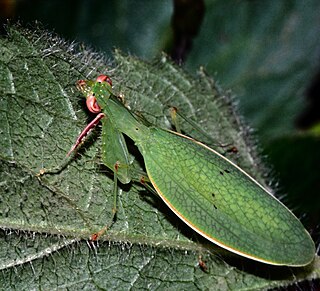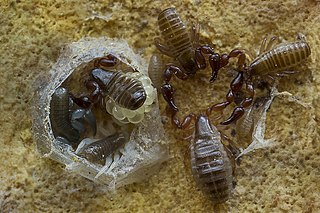
Rutiodon is an extinct genus of mystriosuchine phytosaurs from the Late Triassic of the eastern United States. The type species of Rutiodon, Rutiodon carolinensis, encompasses a large number of skulls and assorted postcranial fossils discovered in the Cumnock Formation of North Carolina. Fossils referable to the species are also known from Pennsylvania, New Jersey, and Virginia. Rutiodon carolinensis is the most well-described species of phytosaur in eastern North America, though its validity as a natural taxon has been questioned. Some paleontologists also recognize a larger and more robust species, Rutiodon manhattanensis, which is known from teeth and postcranial fossils from New Jersey and Pennsylvania.

Periplaneta is a genus of cockroaches containing some of the well-known pest species with cosmopolitan distributions, such as:

Chernetidae is a family of pseudoscorpions, first described by Anton Menge in 1855.

The Nanomantidae are a new (2019) family of praying mantises, based on the type genus Nanomantis. As part of a major revision of mantid taxonomy, genera and tribes have been moved here, substantially replacing the old family Iridopterygidae.
Lagynochthonius is a genus of pseudoscorpions in the family Chthoniidae. It was described in 1951 by Austrian arachnologist Max Beier.
Ideoblothrus is a genus of pseudoscorpions in the Syarinidae family. It was described in 1892 by Italian naturalist Luigi Balzan as a subgenus of Ideobisium.

Geogarypus is a genus of pseudoscorpions in the Geogarypidae family. It was described in 1930 by American arachnologist Joseph Conrad Chamberlin. The genus has a cosmopolitan distribution.

Paratemnoides is a genus of pseudoscorpions in the Atemnidae family. It was described in 1991 by Australian arachnologist Mark Harvey.
Haplochernes is a genus of pseudoscorpions in the Chernetidae family. It was described in 1932 by Austrian arachnologist Max Beier.
Nesidiochernes slateri is a species of pseudoscorpion in the Chernetidae family. It is endemic to Australia. It was described in 1975 by Austrian arachnologist Max Beier.
Nesidiochernes is a monotypic genus of pseudoscorpions in the Chernetidae family. It is native to Oceania, and was described in 1932 by Austrian arachnologist Max Beier.
Paraustrochernes is a genus of pseudoscorpions in the Chernetidae family. It is native to Australasia, and was described in 1966 by Austrian arachnologist Max Beier.
Sundochernes is a genus of pseudoscorpions in the Chernetidae family. It was described in 1932 by Austrian arachnologist Max Beier.
Megachernes is a genus of pseudoscorpions in the Chernetidae family. It was described in 1932 by Austrian arachnologist Max Beier.
Protochelifer is a genus of pseudoscorpions in the Cheliferidae family. It was described in 1948 by Austrian zoologist Max Beier.
Pseudochiridium is a genus of pseudoscorpions in the Pseudochiridiidae family. It was described in 1906 by Danish arachnologist Carl Johannes With.
Solinus is a genus of pseudoscorpions in the Garypinidae family. It was described in 1930 by American arachnologist Joseph Conrad Chamberlin.
Austrohorus is a monotypic genus of pseudoscorpions in the Olpiidae family. It is endemic to Australia. It was described in 1966 by Austrian arachnologist Max Beier.
Beierolpium is a genus of pseudoscorpions in the Olpiidae family. It was described in 1976 by French arachnologist Jacqueline Heurtault.

Olpium is a genus of pseudoscorpions in the Olpiidae family. It was described in 1873 by German arachnologist Ludwig Carl Christian Koch.






